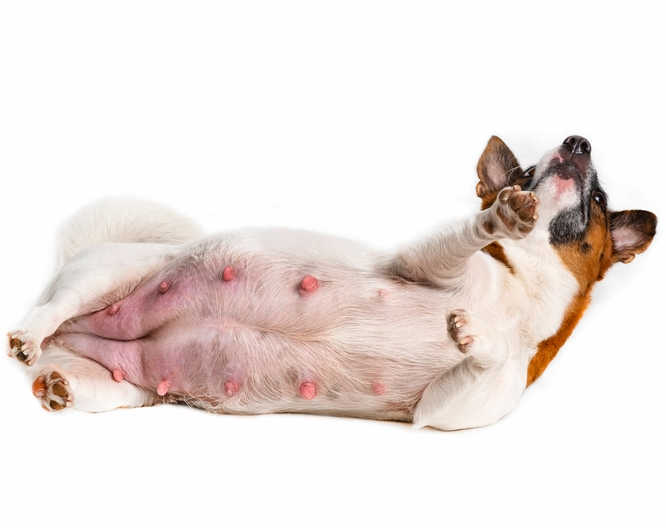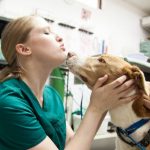
Cute little fur babies bouncing around the house? Yes, please. While the thought of pups can make anyone smile, the process itself can be confusing and worrying. If it has been over 2 months since your dog has been expecting, you should be welcoming the tiny bundles of joy any day now. Dogs are completely capable of smoothly bringing their babies into the world, but you should also know a few things just in case, starting with recognizing the symptoms for when your dog is going into labor.
Before you’re ready to welcome new puppies, be sure you’re taking the right steps to keep the expectant mother healthy.
Your girl’s body or caloric needs won’t change much until around day 35. You’ll then need to increase her daily feedings and nutrition by about 10% every week until she gives birth; she’ll need to be on an energy-dense diet. A healthy female dog should increase her body weight by about 15-20% during pregnancy, but you want to be cautious not to overfeed!
How do I know when labor is close for my dog? What are the first signs?
Rectal Temperature Drop
A dog’s normal body temperature is about 101 F or 38°C. As the delivery time approaches, you should check your girl’s temperature twice a day. If the measured temperature is below 98 F or 36°C, she should be giving birth within the next 24 hours. If your dog doesn’t go into labor after a day from the temperature drop, you should contact your local veterinarian to check for the problems.
Reject food
Most pregnant female dogs will refuse to eat anything before they go into the labor period. This is an early sign that your dog will have labor symptoms soon.
Finding a den
As she nears the delivery, your dog will start exhibiting nesting behavior. She will try to find a den or a corner where she feels safe and comfortable to give birth to her puppies. Your pup may try and drag blankets or bedding to the area she’s chosen. If she already has a box that she likes, make it comfortable and place her in it. She may also get a little anxious and restless. There may also be some panting and pacing involved.
Sickness and vomiting
This is normal for a pregnant dog. She will begin to vomit to empty her stomach typically 6-12 hours before going into labor. Make sure that you have fresh water available for her at all times.
Wanting to be near you all the time
Until it’s time for delivery, she may also want to be close to you. She will follow you everywhere you go and even sleep under your bed. Don’t be surprised by this behavior and be there for her as much as you can.
When the stork arrives: being prepared for your dog to give birth
You’ll want to observe in case there are any complications! Contact your veterinarian (which you should have available on standby) if:
- It takes longer than 24 hours after your girl’s core temperature drops below 100 F (38 C) for labor to begin
- Contractions lasting longer than 30 minutes with no birth.
- More than 2 hours between delivery of offspring
- The puppy appears stuck in the birth canal.
- The mothers gestational period has exceeded 72 days.
- Bloody discharge before the delivery of the first puppy or between fetuses
- Signs that the mother is in pain such as crying or licking her vulva while contracting.
You’ll need to gather supplies for a labor delivery kit! It should include:
- Aspiration Bulb
- Whelping box
- Digital Thermometer
- Heat Lamp
- Sterile scissors
- Gloves
- Heavy thread/ dental floss used to tie umbilical cords
- Antiseptic solution
Be sure you’ve prepared for potential emergencies with a veterinarian on standby or a plan of action if you need veterinary care!
Make sure you offer a stress-free environment! You want to remain as calm as possible for your mother-to-be. Have as few people as possible around the mother while she is giving birth.
Whelping Box
Known as a “whelping box,” this offers a comfortable, secure, preferably quiet, and safe place for your soon-to-be mother to give birth.
Your whelping box might also be referred to as a nesting box. In the wild, a mother wolf will find or dig herself a secure den to act as a nest, offering protection from predators and outside elements. This is an instinctual urge in our dogs as well!
Your whelping box should be set up in a quiet corner of the home. Make it comfortable, lining it with soft sheets and bedding! If you’ve crate trained your girl well enough and your crate is large enough, she may feel more secure in her crate.
You might also consider setting up a nice and comfortable pen during the week prior to delivery! This should be large enough to allow comfortable movement, but small enough so the pups are kept close by in the days to weeks that follow.
Delivery can be a messy ordeal, so you’ll want to be sure any bedding used is replaceable.
Quietly Observe
You’ll want to give your mother plenty of space and freedom while observing for any complications from a reasonable distance. Your girl will feel safer if you aren’t constantly standing over her.
Once your dam does begin to give birth, ensure the pups are free of their covering membranes so they can breathe. The mother should do this on her own, licking and biting at the membranes. You’ll need to intervene if she doesn’t do this – gently break open the thin membranes found covering the puppies.
The stages of dog labor and delivery
Stage 1
Stage one of labor is usually marked by increased anxiety and nesting behavior! She might start whining more often, panting heavily, pacing, or shaking. Your girl might begin to vomit, even refusing to eat.
Your pregnant girl’s uterus will start contracting, causing the cervix to dilate. This stage could last from 6-12 hours.
Your dam may start building something like a nest, dragging clothes and blankets toward a chosen corner of the home. If you have a whelping box, now is the time to get it out.
Stage 2
Your girl will probably seem very alert, panting heavily. Uterine contractions are now clearly visible. After about 15 minutes (usually) of continuous pushing, a greyish sac containing the first pup should emerge! The placenta, or afterbirth, should directly follow.
The mother should tear the sac from her pup, possibly eating this along with the placenta. You’ll have to ensure the sac is removed from her pup’s head so it can breathe, manually removing it if you must. This needs to be done within 30 seconds of the birth!
Your dog will need to expel one placenta per pup born.
If your dam doesn’t gnaw on her umbilical cord, you’ll have to clamp it 2 inches from her abdomen with sterilized hemostat forceps.
Hold your pup, angling it head-down. Use your pediatric syringe or aspiration bulb to withdraw any fluids from the pup’s mouth and allow breathing! You may need to clear the airways of all six or so pups.
Stage 3
Your girl’s uterus will expel any remaining blood, fluid, and placenta. Her pups should begin to nurse as soon as it is possible after being delivered. The first ‘milk’ produced is actually very rich in nutrients and antibodies, this is called the colostrum and it’s vital that all puppies get enough of this.
You should call the veterinarian if your dog has the following symptoms:
- Strong contractions for about an hour or more with no puppy out while you know that there are still more puppies inside her body.
- About 3-4 hours pass and there are still more pups inside your dog’s body.
- Failure to have labor after 1 day passes from the period of temperature drop.
- The gestation period of more than 70 days with no labor symptoms.
Related posts:


